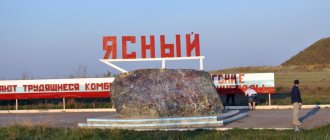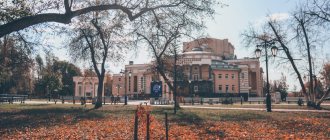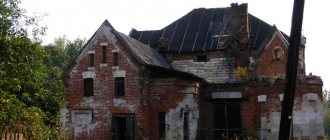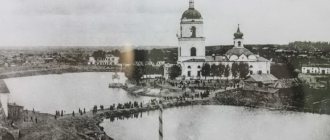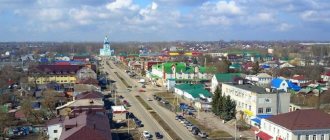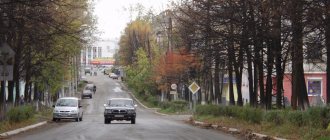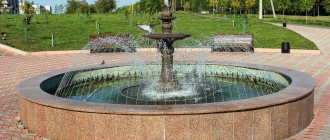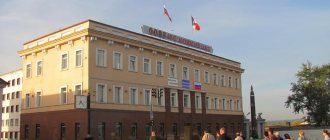Asbest is one of the industrial cities of the Middle Urals. It was built on the edge of a huge quarry in which chrysolite asbestos was mined. The city is located on the right bank of the winding Bolshoi Reft river in the area of Shchuchye Lake. On the satellite map of Asbest you can see that the entire eastern outskirts are occupied by a quarry and dumps, the western by the Bolshoy Reft and Cheremsha rivers, and between them the microdistricts of the “working” town are comfortably located.
From Asbest to Yekaterinburg it is about 80 km. As shown on the map of Asbest with diagrams, the city and other settlements of the Urals are connected by several roads. You can also come to the city, where asbestos has been mined and processed for more than 100 years, by train.
About 66 thousand people live on the territory of the settlement, most of whom work at the main enterprise of the city, UralAsbest. This and other industrial enterprises, as the Asbest map by region allows, are located on the outskirts of the city on the southern and eastern sides.
City `s history
The history of the city begins at the beginning of the 19th century, when the peasants of the Beloyarsk settlement in the swamps near Lake Shchuchye stumbled upon a fibrous mineral - mountain tow , as it was called at that time. Then the place was christened Kudelnoye swamp .
Photo source: Unique Asbestos
However, the official chronicle of asbestos deposits begins in 1884, when UOLE member A.P. Ladyzhensky, near the Kudelny swamp , discovered mineral outcrops, reporting this to the Mining Department . The place was named Bazhenovskoye field - after the Bazhenovo station , located nearby. In post-Soviet times, one of the city streets was named mountain flax
In 1885, the rights to the asbestos deposit were received Ladyzhensky by the Partnership for the Exploitation of Ural Minerals . At the same time, the first asbestos mine appeared, called Voznesensky .
Photo source: Unique Asbestos
And 4 years later, after receiving official permission to develop the deposit from the Mining Department , 11 mines were opened in this area, which became the starting point for the formation of the future city. The newly formed settlement was named after the discovered mineral - the village of Kudelka . 3 sorting factories were also opened. The deposit was developed primarily by manual labor - working conditions, to put it mildly, were difficult.
Gradually, the village's industry developed - in 1896, the first steam engine for pumping water began working at one of the mines, and a year later an asbestos processing factory appeared - the first in Russia . By 1917, 4 private enterprises were operating at the Bazhenovskoye field . They produced about 200 thousand tons of high-quality asbestos, which was sent to Austria , Japan , England and Germany .
Photo source: Unique Asbestos
Uralasbest trust was created , which united the mines of the Bazhenovsky , Nevyanovsky and Rezhevsky districts.
In the early 1930s, the rapid development of the village began - a geological museum appeared, a mining technical school and a secondary school opened, a Palace of Culture with a cinema hall, a hospital complex, as well as a printing house and a furniture factory began operating. And in 1933, the village received city status and a new name - Asbest .
Photo source: Unique Asbestos
In the post-war period, the city continued its development - by the end of the 1960s, Asbest already had a constant bus service, several schools, a hotel and restaurant, a large-format cinema, a sports club, a driving school, and a rest home. In addition, several plants and factories were opened.
Today, Asbest is a typical Central Ural industrial town, not without its own individual features and characteristics.
Literature[ | ]
- Asbestos // Cities of Russia: encyclopedia. - M.: Great Russian Encyclopedia, 1994. - P. 28. - 559 p. — 50,000 copies. — ISBN 5-85270-026-6.
- Pages from the book by Amosova L.F.
Asbest.
Life and fate (undefined)
(inaccessible link -
history
). - A brief overview of the development of land around the future city of Asbest in the 17th-19th centuries (unspecified)
(inaccessible link). Archived from the original on July 23, 2010. - Antonov A.A. Mineralogy of rodingites of the Bazhenov hypermafic massif // St. Petersburg: Nauka, 2003, 128 p.
- Erokhin Yu. V. Supergene copper minerals in gabbros of the Bazhenov deposit // Ural Summer Mineralogical School-96 (materials). Ekaterinburg: UGGGA Publishing House. 1996. pp. 180-183.
- Zadov A. E., Chukanov N. V., Organova N. I., Kuzmina O. V., Belakovsky D. I., Nechai V. G., Sokolovsky F. S., Kuznetsova O. Yu. Comparative study of rosenhanite from California and the Urals, refinement of the formula // Notes of the RMO, 2000, 119, 2. p. 85 - 96.
- Kleimenov D. A., Albrecht V. G., Koroteev V. A. et al. Bazhenovskoe deposit of chrysotile asbestos // Famous deposits of the Urals. Part I. - Ekaterinburg: Basko Publishing House, 2006, p. 84-119.
- Kobyashev Yu. S., Nikandrov S. N. Minerals of the Urals (mineral types and varieties) // Ekaterinburg: KVADRAT Publishing House, 2007, 312 p.
- Loskutov A. B., Novgorodova E. A. Minerals. Bazhenov chrysotile asbestos deposit // “Ural Worker”, 2013, 340 pp.
- Mineralogy of rodingites of the Bazhenov chrysotile-asbestos deposit (a guide to student ore-mineralogical practice). Ekaterinburg, Ural Summer Mineralogical School-96. 1996, 95 p.
- Pekov I. V. Chukanov N. V. Filinchuk Ya. E. Zadov A. E. Kononkova N. N. Epanchintsev S. G. Kaden P. Kutzer A. Göttlicher J. Kasatkinite Ba2Ca8B5Si8O32(OH)3 6H2O - a new mineral from the Bazhenov deposit (Middle Urals, Russia) // ZRMO, 2012, 141(3), 39-49. Proceedings of the RMO, 2012, 141(3), pp. 39-49.
Sights of Asbest
Museum of the Uralasbest plant
Photo source: Asbestos News
The museum's collections contain various minerals and rocks mined in the vicinity of the city - in the Bazhenov deposit . Also here you can see various products made of asbestos and serpentinite. A separate exhibition is dedicated to the history of the Bazhenovskoye field and, accordingly, the city.
In the museum you can learn about the history, awards and work of the plant itself.
Address: st. Lenina, 14
Asbestovsky Historical Museum
Photo source: Asbestos Historical Museum
Here visitors will be told about asbestos itself, for example, about its use in Ancient Greece and Corsica . So it is about the history of the city - about the contribution of city residents to the victory in the Great Patriotic War , about the work of various factories, about the life and culture of asbestos workers in different periods.
The most valuable exhibits are a desk, a gramophone and a cabinet piano from the 19th century, as well as an antique cast bell.
Asbestovsky Historical Museum
Address: Asbest, st. Mira 12 Contacts: +7 (34365) 2-90-51 Website: uole-museum.ru
Memorial Museum N.M. Avvakumova
Photo source: semantic.uraic.ru
Nikolay Avvakumov is one of the most famous graphic artists in the Urals . At one time he worked as an art correspondent, sketching the most important moments and events of the era. most famous works are portraits of the country’s first people, as well as his posters, sketches, and graphic reports dedicated to military operations (during the war years, the artist worked as an artist-correspondent for the Frontovik newspaper as part of the 3rd Shock Army).
However, a separate part of the life of the graphic reporter is connected with the city of Asbest , in connection with which a museum was created. The memorial museum was opened in 1976 in the Palace of Pioneers . Here you can get acquainted with the life and works of Nikolai Mikhailovich .
Address: st. Uralskaya, 75
Monument to A.P. Ladyzhensky
Photo source: situr.rf
Ladyzhensky is the discoverer of the Bazhenov deposit and, in fact, the person without whose discovery Asbestos would not have appeared. Therefore, it is only logical that a monument was erected in his memory. In addition, Alexey Pavlovich is one of the first participants in the Ural Society of Natural History Lovers . The monument is located opposite the Palace of Pioneers and is a bust of the discoverer on a pedestal.
GPS coordinates: 57.013474, 61.469913
Victory Alley
Victory Alley is one of the central alleys of the city, where people come to relax and stroll among the trees. The main city monuments related to the wars are concentrated here - the monument to internationalist soldiers ; a monument to the soldiers who died in the North Caucasus (or a monument to the soldiers of the Urals), as well as the largest monument in the city - the Victory Memorial , erected for the 20th anniversary of the victory in the Great Patriotic War .
Photo source: situr.rf
Also on the Alley is the most famous bench of the city - the Bench of Reconciliation , which was installed at his own expense by one of the residents of Asbest . The right and left sides of the bench are at an angle, so people sitting on it gradually slide towards each other. The bench is located not far from the city court - so that people going to court have the opportunity to reconcile on their own (at least think about it).
Photo source: newsland.com
GPS coordinates: 57.014240, 61.462013
Sculptures at the House of Culture
The sculptures at the entrance to the House of Culture depict two muses and appeared here in the mid-50s of the 20th century, immediately after the completion of the construction of the House of Culture . For a long time, the author of the muses remained a mystery - it was assumed that they were made by Ernst Neizvestny , but there was no official confirmation.
The information was confirmed only in 2013, when a local historian contacted Neizvestny personally. The latter immediately recognized his muses. It is believed that the sculptures are Neizvestny’s .
Let us remind you that in Yekaterinburg there is a museum of Ernst the Unknown .
Address: st. Osipenko, 32
Transport[ | ]
Bus station in Asbest from the side of the platforms Industrial traction unit PE2M with a freight train at Vostochnaya station
| Bazhenovo - Reft | |||||||||||||||||||||||||||||||||||||||||||||||||||||||||||||||||||||||||||||||||||||||||||||||||||||||||||||||||||||||||||||||||||||||||||||||||||||||||||||||||||||||||||||||||||||||||||||||||||||||||||||||||||||||||||||||||||||||||||||||||||||||||||||||||||||||||||||||||||||||||||||||||||||||||
| Sverdlovsk Railway | |||||||||||||||||||||||||||||||||||||||||||||||||||||||||||||||||||||||||||||||||||||||||||||||||||||||||||||||||||||||||||||||||||||||||||||||||||||||||||||||||||||||||||||||||||||||||||||||||||||||||||||||||||||||||||||||||||||||||||||||||||||||||||||||||||||||||||||||||||||||||||||||||||||||||
| Legend | |||||||||||||||||||||||||||||||||||||||||||||||||||||||||||||||||||||||||||||||||||||||||||||||||||||||||||||||||||||||||||||||||||||||||||||||||||||||||||||||||||||||||||||||||||||||||||||||||||||||||||||||||||||||||||||||||||||||||||||||||||||||||||||||||||||||||||||||||||||||||||||||||||||||||
The city is connected by a railway line to the Trans-Siberian Railway. The length of the route is 36 kilometers. The line is electrified. Near the city there are railway stations SvZD Asbest and Izumrud. Asbest station is now the terminal for passenger traffic and connects the public railway network with the departmental electrified railway network of Uralasbest OJSC, which is also electrified and through which rocks from the asbestos quarry are transported using industrial traction units. Previously, the railway had an extension to the village of Reftinsky and was connected to another railway line. From the Asbest station in a southern direction, passenger service is carried out by electric trains to Yekaterinburg and other cities of the Sverdlovsk region. Return electric trains from Yekaterinburg go only to Izumrud station, and do not reach Asbest station. Due to the remoteness of both stations, bus No. 5 runs from the residential areas of the city to the Izumrud station closest to the city, connected to the morning and evening trains. Bus No. 2a runs from the city to the Asbest station and the village “101 block” located next to it. To the north of Asbest station there are also freight stations Vostochnaya and Severnaya [ source not specified 1854 days ]. There is also the Asbestov Passenger Motor Transport Enterprise (APATP) in the city. It provides intracity, suburban and intercity communication. Almost all routes depart from the bus station[41][42]. The lines operate LiAZ-5256, Kia Granbird, and Hyundai Universe buses[43]. Previously, buses were used: LiAZ-677 (until 2011-2012[44][45][46]), LAZ-695N (until 2013[47]), Ikarus-280 (since 2010 they were used only in summer time, the latter were decommissioned in 2014[48]), Ikarus-250 (until 2014[49]), Ikarus-256 (until 2014[50]), Ikarus-260 (until 2014[51]) . Most APATP buses are in poor technical condition. Purchases of new buses are carried out in insufficient quantities. This led to the cessation of traffic on routes No. 2 and No. 4. The number of flights on existing routes was also significantly reduced[52]. The bus fleet is rapidly declining due to physical aging and wear and tear of buses. In addition to APATP, suburban routes are served. Flights are available
Since 2011, these flights have departed from the Asbestov bus station. In addition to them, there is a flight from Izumrud station. A network of minibus taxis is also developing in the city. There are routes that duplicate bus routes, such as 1k and 2a, 102a and 102b[42]. In addition, there is a ring route, routes No. 3 and No. 9 have been restored and are in operation. Since 2011, all minibuses depart from the Asbestovsky bus station [ source not specified 1854 days ]. | |||||||||||||||||||||||||||||||||||||||||||||||||||||||||||||||||||||||||||||||||||||||||||||||||||||||||||||||||||||||||||||||||||||||||||||||||||||||||||||||||||||||||||||||||||||||||||||||||||||||||||||||||||||||||||||||||||||||||||||||||||||||||||||||||||||||||||||||||||||||||||||||||||||||||
Abandoned Asbestos
In addition to the main attractions, there are quite a lot of interesting abandoned objects Asbest
Photo source: Unique Asbestos
One of the most interesting is the cemetery of agricultural machinery in the village of Krasnoarmeyskoye . In total there are about 30 pieces of equipment - all kinds of trailers, tractors, buses, combines and others.
Photo source: Unique Asbestos
Another abandoned landmark of the city is a 5-story water tower (height 35 meters). Initially, the tower was the tallest building in the city, but with modern development its height no longer seems so outstanding. The tower is installed in the historical center of Asbest - today it is literally the edge of the quarry.
Water Tower / Photo Source: Unique Asbestos
the USA in the early 2000s - for Russia such architecture is unique.
Abandoned greenhouse on Reftinsky / Photo source: Unique Asbest
greenhouse complex on Reftinsky has become quite a popular place . There are 14 dilapidated greenhouses on the territory, connected by a common corridor. In addition, a 2-story administrative building, a utility building, 3 security booths and several utility sheds have been preserved here. At first glance, there is nothing interesting in the greenhouses, but they make for surprisingly atmospheric photographs.
Population[ | ]
| Population | |||||||||||
| 1926[15] | 1931[15] | 1939[15] | 1959[16] | 1962[15] | 1967[15] | 1970[17] | 1973[15] | 1976[15] | 1979[18] | 1982[19] | 1986[15] |
| 7600 | ↗29 700 | ↗30 000 | ↗60 053 | ↗65 000 | ↗74 000 | ↗75 508 | ↗79 000 | ↘78 000 | ↗78 673 | ↗80 000 | ↗83 000 |
| 1987[20] | 1989[21] | 1992[15] | 1996[15] | 1998[15] | 2000[15] | 2001[15] | 2002[22] | 2003[15] | 2005[15] | 2006[15] | 2007[15] |
| →83 000 | ↗84 470 | ↗85 100 | ↘83 200 | ↘82 200 | ↘81 200 | ↘80 600 | ↘76 328 | ↘76 300 | ↘73 800 | ↘72 800 | ↘71 900 |
| 2008[23] | 2009[24] | 2010[25] | 2011[15] | 2012[26] | 2013[27] | 2014[28] | 2015[29] | 2016[30] | 2017[31] | 2018[32] | 2019[33] |
| ↘71 300 | ↘70 813 | ↘68 893 | ↗68 900 | ↘68 104 | ↘67 414 | ↘66 855 | ↘66 108 | ↘65 305 | ↘64 666 | ↘64 091 | ↘63 325 |
| 2020[34] | 2021[2] | ||||||||||
| ↘62 908 | ↘62 285 | ||||||||||
As of January 1, 2022, in terms of population, the city was in 261st place out of 1,116[35]cities of the Russian Federation[36].
Asbestos Quarries
Kvartalny Quarry / Photo source: Unique Asbest
The Asbestov quarry is probably the most famous landmark of the city. If you open any electronic map, you will immediately see that the quarry is almost larger than the city itself. It is also interesting that it is located in the very center (geographical) of Asbest , and not on the outskirts, as is often the case. The quarry stretches 11 kilometers long, 2.5 kilometers wide and 350 meters deep.
Aul quarry / Photo source: Unique Asbestos
Here we described the Asbestos quarry in detail.
Malyshevsky dump / Photo source: Unique Asbest
The surroundings of Asbest are also rich in various quarries - Krasnobolotinsky mine , Aulsky quarry , Kvartalny quarry , Krasnoarmeysky mine and others.
Administrative and municipal status
Within the structure of administrative units, this is together with the workers' settlements of Malyshevo and Reftinsky and five rural areas included as Asbest Town
[1] - administrative unit with a status equal to that of districts.[10]
As a municipal entity, Asbest and two rural settlements are united as the Asbest urban district
.[4] The urban-type settlement of Malyshevo, together with three other rural settlements, is included separately as the Malyshevsky urban district, and the urban settlement of Reftinsky separately as the Reftinsky urban district.[4]
Recommendations
Notes
- ^ a b c d
State Committee of the Russian Federation on Statistics.
Committee of the Russian Federation for Standardization, Metrology and Certification. No. OK 019-95 January 1, 1997 “All-Russian classifier of objects of administrative-territorial division. Code 65 409”, Ed. changes No. 278 / 2015 dated January 1, 2016. (State Committee of the Russian Federation on Statistics. Committee of the Russian Federation on Standardization, Metrology and Certification. No. OK 019-95 January 1, 1997 Russian Classification of Administrative Objects (OKATO). Code 65 409
As amended by Amendment No. 278/2015 dated January 1, 2016). - ^ a b
Federal State Statistics Service of Russia (2011).
“All-Russian Population Census 2010. Volume 1" [All-Russian Population Census 2010, vol. 1]. All-Russian Population Census 2010 [All-Russian Population Census 2010]
(in Russian). Federal State Statistics Service. - "26. The size of the permanent population of the Russian Federation by municipalities as of January 1, 2022.” Federal State Statistics Service. Retrieved January 23, 2022.
- ^ a b c d
Law No. 85-OZ - "On the calculation of time." Official Internet portal of legal information
(in Russian). June 3, 2011. Retrieved January 19, 2022. - Post office. Information and computing center of OASU RPO. ( Post office
).
Search for postal facilities ( Search for postal facilities
) (in Russian) - Federal State Statistics Service of Russia (May 21, 2004). “The population of Russia, the constituent entities of the Russian Federation as part of federal districts, urban settlements, urban settlements, settlements, settlements is 3 thousand or more people” [Population of Russia, its federal districts, constituent entities of the federation, districts, urban settlements, rural settlements - administrative centers, rural settlements with a population of more than 3000 people] (XLS). All-Russian Population Census of 2002 [All-Russian Population Census of 2002]
(in Russian). - “All-Union Population Census of 1989. The current population of union and autonomous republics, autonomous regions and districts, territories, regions, urban settlements and rural district centers” [All-Union Population Census of 1989: current population of union and autonomous republics, autonomous regions and districts, territories, regions, districts, urban settlements and villages that are district administrative centers]. All-Union Population Census of 1989 [All-Union Population Census of 1989]
(in Russian).
Institute of Demography of the National Research University: Higher School of Economics [Institute of Demography of the National Research University: Higher School of Economics]. 1989 - via Demoscope weekly
. - Kopyrin, Alexander Leonidovich (2012). Asbestos.
Koudelka. Copy . Asbestos. ISBN 978-5-9903980-1-6. - Law No. 30-OZ
- Tossavainen, Antti; Kovalevsky, Evgeniy; Wanhala, Esa; Vanhala, Timo; Twomey, Timo (2000). "Pulmonary mineral fibers following occupational and environmental asbestos exposure in the Russian chrysotile industry." American Journal of Industrial Medicine
.
37
(4): 327–333. Doi:10.1002/(SICI)1097-0274(200004)37:4 3.0.CO; 2-1. PMID 10706743. - Shleynov, Roman (July 20, 2010). "The world's asbestos behemoth." Center for Public Integrity. Missing or empty | url = (help)
